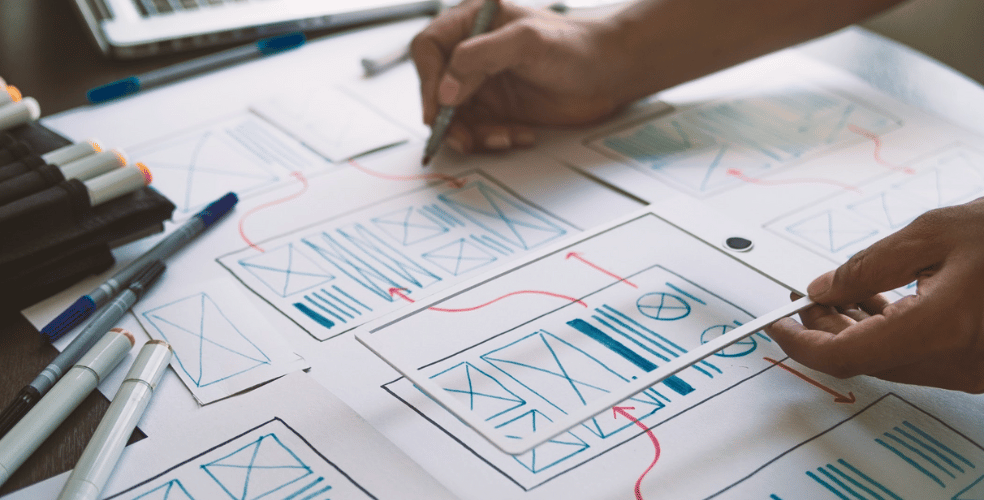Our design teams spend a lot of time working with clients who are trying to change or build a digital service. This usually involves some user research, gathering insights from that research and prototyping possible avenues ahead of implementation.
At earlier stages of work, I’ve found that the use of the word ‘prototype’, and even prototyping as an approach, can be a little unclear. Here are some principles that you might think about if you’re planning some prototyping.
Make prototyping part of your early research
Sometimes it’s difficult, or more time consuming, to gain a full understanding of a problem or user need by simply asking people exploratory questions. Often you’ll gain knowledge more efficiently by putting a ‘thing’ in front of a user and asking them to interact with it. Through exploration of a prototype or artefact, you can frame your research questions in a way that is grounded and relatable to your users, producing more actionable and precise insights. This can also be a useful tool for engaging different mindsets and ways of thinking.
While creating prototypes early might appear daunting and time-consuming, it's important to remember that their complexity should only be proportional to the hypothesis being tested. To validate many hypotheses, you can use lower fidelity prototyping, such as paper prototypes, wireframes, data artefacts (such as maps), content documents, and static clickable prototypes to keep costs down and timeframes under control.
Researching early with prototypes and artefacts also opens up new research methods. For example, we’ve used highlighter testing to understand what parts of a policy or communication users feel most uncertain about. Allowing the user to interrogate a prototype in this way before discussing it will give them the opportunity to fully form their thoughts, creating higher quality responses and insights.
Start thinking about data
Real data is queen, but informed ‘dummy’ data can still be useful to learn from, especially with early prototypes. If you intend to research and prototype with real data, you’ll have to set aside enough time to obtain the data, tackle any appropriate internal governance, and create the environment needed.
This can mean weeks or even months of working with your colleagues in policy, comms, IT and cybersecurity, or allowing time for another team, organisation or workstream to create the data that you’ll be working with.
In most cases, an early prototype will be great at starting a conversation with your teams about data requirements and the technical viability of a proposed solution, a key step to issuing good recommendations for future builds.
If testing real data is key to validating a hypothesis, and this data is not yet available to you, you may need to consider postponing this work until you do. When all is said and done, discussions about infrastructure, planning and logistics can easily consume more time and budget than the prototyping itself.
Get content design involved
It might be tempting to ‘do the words’ later. But this is a missed opportunity.
If you’re working with a content designer, involving them at an early prototyping stage means they can bring a different angle on the user’s perspective. A big part of this is by using clear language, which is easy to read and understand. But it might also be things like removing content at that stage in the journey, to avoid cognitive overload. Or perhaps there’s an entirely new concept in the prototype that users need help to understand. That might be possible by using micro-copy to give clarity, or it might require a standalone page or piece of guidance.
Content designers can also work with you on information architecture. This could be by taking the findings from research methods like card sorting, and helping to organise content in the prototype in a way which makes sense to users and their mental models. Including how menus and categories are named and labelled.
And if you’re flying solo, you can still use content design as part of your early prototyping. For example, try replacing any ‘placeholder’ text with real, action-focused words and sentences. Does the content on each screen guide the user to the next step or action they should take?
Protect prototyping as an ongoing priority
Early prototyping can add value right through to live product delivery and teams focusing on continuous improvement work. With this in mind, it’s important to consider how you shape projects and statements of work as work continues to accommodate prototyping. How is that activity described and costed? Does the team shape reflect the need for prototyping at all project stages?
You’ll also have to think about how you defend the value of prototyping to other stakeholders as the project kicks off and inevitably gets delayed or extended. Public money is precious and clients are under pressure to deliver on outcomes quickly. Prototyping at all stages helps uncover a thousand unseen assumptions, and as with any preventative measures, is always worth protecting.

